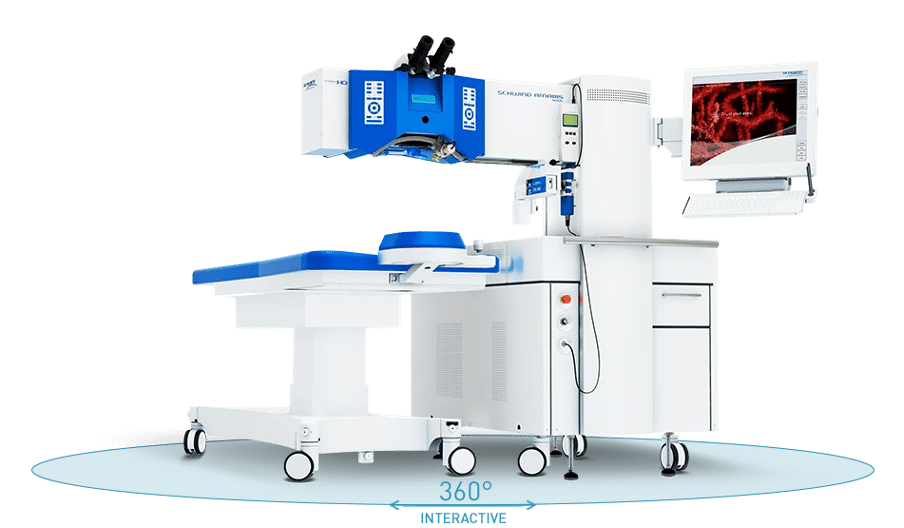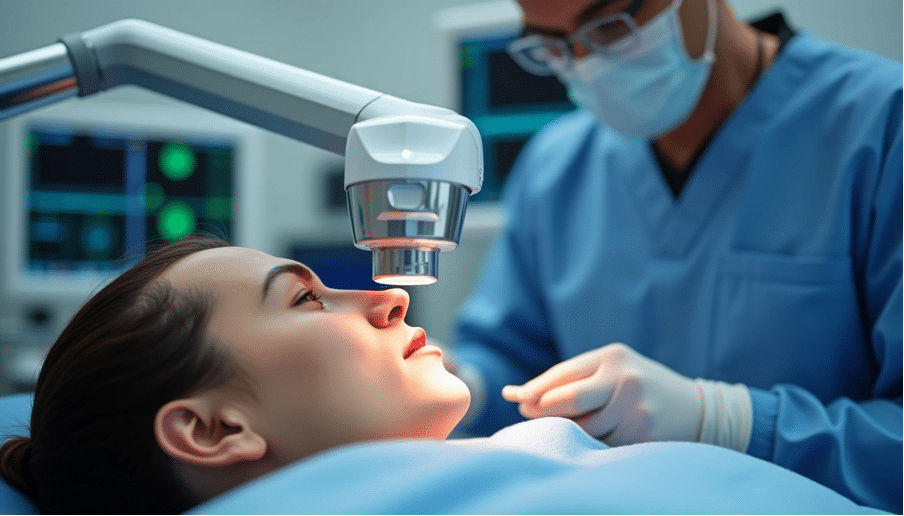The SCHWIND AMARIS 1050RS treats each dioptre of myopia in just 1.3 seconds, making it the fastest laser eye surgery technology accessible to more people today. Speed matters in vision correction—not just to save time, but to ensure your safety and optimal results. This remarkable system operates at 1050 Hz and stands as the only excimer laser with such capabilities in the market.
Clinical outcomes prove why eye surgeons call this technology superior. The system achieves refractive accuracy within ±0.50 D in 99% of treated eyes, while 55% of patients see improvement of one or more Snellen lines in vision quality. The system’s advanced 7D eye tracker works 1050 times per second to maintain precision throughout your procedure.
Your vision correction experience brings remarkable results—42% of patients achieve uncorrected visual acuity of 20/16 or better. Shorter treatment times prevent corneal dehydration and improve accuracy. A retreatment rate below 0.3% gives you confidence in both the original procedure and long-term outcomes. The technology behind your treatment plays a crucial role as you think over laser eye surgery options. The SCHWIND AMARIS 1050RS stands at the forefront of laser vision correction with unmatched speed, precision, and safety that sets it apart.

What Is the SCHWIND AMARIS 1050RS and Who Is It For?
The SCHWIND AMARIS 1050RS stands at the forefront of excimer laser technology in corneal refractive surgery. This system offers exceptional precision for vision correction procedures at Precision Vision London. The advanced system runs at an extraordinary 1050 Hz repetition rate, which makes it the fastest excimer laser available worldwide.
Laser Type and Treatment Methods (LASIK, TransPRK)
The AMARIS 1050RS excels at both flap-based and surface treatments. During LASIK procedures, the system works alongside a femtosecond laser (such as the IntraLase iFS) to create a protective corneal flap. The AMARIS reshapes the underlying corneal tissue after lifting the flap, which is then repositioned.
The system also excels with TransPRK (transepithelial photorefractive keratectomy), an innovative “no-touch” technique that only advanced excimer technology can perform. TransPRK applies laser energy directly to the corneal surface without cutting, brushing, or creating a flap. SmartSurfACE technology improves this approach by creating an exceptionally smooth cornea after treatment. This speeds up healing and vision recovery compared to conventional surface procedures.
Target Conditions: Myopia, Hyperopia, Astigmatism
The AMARIS 1050RS treats a complete range of refractive errors:
- Myopia: Clinical studies reveal that 95.1% of eyes achieve 20/20 uncorrected vision within three months
- Astigmatism: The results show 96% of treated eyes have refractive astigmatism of 0.25D or less after treatment
- Hyperopia: The system corrects far-sightedness with precision using wavefront-guided approaches
Clinical data shows exceptional predictability, with 97.7% of eyes falling within ±0.50D of intended correction. This accuracy makes the AMARIS 1050RS invaluable for patients with challenging prescriptions.
Why Surgeons Prefer It for Complex Cases
Surgeons at Precision Vision London rely on this technology for complex cases because of its innovative 7D eye tracking system. This feature tracks eye position 1050 times per second with just 1.6 milliseconds of latency. The system compensates for eye movements in all seven dimensions—including subtle rotations and forward/backward movements—to deliver precise treatment.
The system’s dual energy approach delivers better outcomes. It performs 80% of ablation at high fluence for speed and switches to lower fluence for the final 20% to achieve fine precision. The Intelligent Thermal Effect Control algorithm maintains corneal temperature rise below 5°C, which is nowhere near the thresholds that could risk tissue damage.
Core Technologies Behind the Safest Laser Eye Surgery
Precision Vision London’s laser eye procedures rely on innovative technology that makes the SCHWIND AMARIS 1050RS stand out. The system’s core technologies prove why surgeons call it the safest choice to correct vision.

7D Eye Tracker: Live Movement Compensation
The system’s precision comes from its groundbreaking 7D eye tracking technology. This advanced tracker goes beyond standard systems and monitors eye movements in seven dimensions 1050 times per second. These dimensions track horizontal and vertical changes, rolling movements, cyclotorsion (rotation around the visual axis), z-axis movements, and time. The “Latency-Free Tracking” feature can predict eye movements before they happen, which results in zero delay during treatment.
Laser Speed: 1050 Hz and 1.3 Seconds per Dioptre
The SCHWIND AMARIS 1050RS runs at 1050 Hz repetition rate—the highest speed among all excimer lasers today. This remarkable speed needs just 1.3 seconds per dioptre to correct myopia. A -8 dioptre treatment takes about 11 seconds. This quick process reduces corneal dehydration risk and shortens fixation time.
0.54 mm Spot Size: Precision and Smoothness
The system uses an ultra-fine laser beam of 0.54 mm diameter to achieve exceptional precision. This spot size—the smallest among clinical excimer lasers—creates complex ablation profiles even at high speeds. The result is an extremely smooth corneal surface that helps faster healing and visual recovery.
Dual Energy Levels: Fast Ablation and Smooth Finish
A unique two-tier approach drives the treatment process. The system ablates about 80% at high energy levels quickly, then switches to lower energy for the final 20%. This smart approach optimises both speed and precision, especially when it corrects higher-order visual aberrations.
Thermal Control System: Protecting Corneal Tissue
The Intelligent Thermal Effect Control (ITEC) algorithm keeps corneal temperature under 5°C during treatment—substantially lower than the 40°C mark that could damage tissue. This smart system spreads laser pulses across space and time. Each treated area gets enough cooling time before receiving more pulses.
Clinical Outcomes UK-Based Tests
New UK tests show outstanding results for the SCHWIND AMARIS 1050RS. These detailed clinical evaluations clearly show why this technology sets the standard for laser vision correction.
Visual Acuity Gains: BSCVA and UCVA Improvements
Studies reveal 95.1% of treated eyes achieve uncorrected distance visual acuity of 20/20 or better. Some centres report even higher success rates of 99.4%. The results show 43% of patients gained one or more Snellen lines. All but one eye in these studies maintained their vision lines. The mean safety index stands at 1.0±0.02, which proves this technology maintains and often improves existing vision quality.
Refractive Accuracy: ±0.25D and ±0.50D Results
The data shows 97.7% of eyes achieve results within ±0.50D of intended correction. About 70% reach refractive results within ±0.25D of emmetropia. The mean postoperative spherical equivalent is just +0.02±0.21D, which shows near-perfect correction of refractive error. Current laser platforms are nowhere near this level of precision.
Astigmatism Correction and Stability Over Time
The results for astigmatism correction stand out. About 96% of treated eyes show 0.25D or less in residual astigmatism. The mean cylinder reduction reaches 0.13±0.25D. Studies over six months demonstrate stable outcomes with mean defocus of just -0.14±0.31D. Patients see stable results within one week that continue through long-term checkups.
Aberration-Free Results: HOAs and Contrast Sensitivity
The system preserves corneal higher-order aberrations while reducing specific ones. Total corneal HOA root-mean-square dropped by 0.157µm. Vertical and horizontal coma decreased by 0.049µm and 0.045µm respectively. The spherical aberration changes stayed statistically insignificant, which maintains natural optical quality.
Retreatment Rates and Long-Term Safety
The retreatment rate stands at just 0.3% among 3,880 LASIK procedures. Major clinical evaluations reported no significant surgical complications, which highlights the technology’s safety record. This mix of accuracy and safety explains why Precision Vision London’s surgeons choose the SCHWIND AMARIS 1050RS for complex vision correction cases.
What This Means for Patients at Precision Vision London
Patients at Precision Vision London will find the SCHWIND AMARIS 1050RS provides remarkable benefits beyond clinical data. This advanced technology enhances your comfort, speeds up recovery, and improves overall satisfaction.
Faster Recovery and Less Discomfort
The healing process moves quickly, with 80-90% of recovery happening within 24 hours after LASIK surgery. Your LASIK procedure takes just 10 minutes for both eyes. Patients usually feel mild prickling sensations during this touch-free treatment, despite its sophisticated nature. Recovery becomes simple with topical antibiotics, anti-inflammatory drops, and artificial tears.

Suitability for Active Lifestyles and High Visual Demands
You can return to your regular activities quickly after the procedure:
- Office work and driving resume within 24-48 hours
- Light exercise like walking starts after 3 days
- Moderate exercise such as jogging begins after one week
- Heavy weightlifting resumes after two weeks
- Swimming restarts after two weeks (goggles required)
Personalised Treatment Planning with ORK-CAM
The smart SCHWIND ORK-CAM module serves as your perfect planning companion for successful vision treatment. This advanced software works with the AMARIS 1050RS and supports all common ablation techniques—LASIK, FemtoLASIK, LASEK, PRK, and touch-free TransPRK. Your cornea gets mapped at 150,000 unique points, creating custom treatments.
Why Our Surgeons Trust the AMARIS 1050RS
The SCHWIND AMARIS 1050RS at Precision Vision London delivers the safest and most precise laser eye surgery technology. Our laser eye experts welcome you to book a consultation today. This technology helps our surgeons deliver consistent excellence 99% of treated eyes achieve vision within ±0.50D of the target prescription. Patients enjoy lasting results with minimal maintenance as their vision typically stabilises within 2-3 months.
Conclusion
The SCHWIND AMARIS 1050RS represents a breakthrough in laser eye surgery technology. Its extraordinary 1050 Hz operation speed treats each dioptre of myopia in just 1.3 seconds and cuts down procedure time while boosting safety. The revolutionary 7D eye tracking system delivers precision that eye surgeons at Precision Vision London rely on for complex cases.
Clinical outcomes from 2025 UK-based tests confirm this trust. A remarkable 97.7% of eyes achieve refractive accuracy within ±0.50D. On top of that, the low 0.3% retreatment rate shows reliable first-time results patients can depend on. Your path to clear vision deserves this level of precision. The advanced thermal control system protects corneal tissue during treatment. The dual energy approach combines speed with precision. These state-of-the-art features lead to faster recovery times, less discomfort, and outstanding visual results. Most patients return to normal activities within days.
Benefits go beyond the clinic. You can resume office work within 48 hours after your procedure at Precision Vision London and start active pursuits within weeks. The ORK-CAM module creates personalised treatment plans that address your specific visual needs instead of using a one-size-fits-all approach.
Your vision correction experience deserves the safest, most advanced technology. The SCHWIND AMARIS 1050RS gives you unmatched speed, extraordinary precision, and proven results that set standards for laser eye surgery in 2025 and beyond. Note that the technology behind your treatment is vital for your comfort and long-term visual outcomes. The exceptional results at Precision Vision London showcase surgical expertise and technological excellence working together for you.
FAQs
Q1. What makes the SCHWIND AMARIS 1050RS stand out among laser eye surgery technologies? The AMARIS 1050RS operates at an unmatched 1050 Hz repetition rate, treating each dioptre of myopia in just 1.3 seconds. It features a 7D eye tracking system and dual energy approach, ensuring unparalleled precision and safety during procedures.
Q2. How long does recovery typically take after treatment with the AMARIS 1050RS? Most patients experience 80-90% recovery within the first day after surgery. You can usually return to office work and driving within 24-48 hours, and resume most normal activities within a few weeks.
Q3. What types of vision problems can the AMARIS 1050RS correct? The system effectively treats a wide range of refractive errors, including myopia (short-sightedness), hyperopia (far-sightedness), and astigmatism. It’s particularly valuable for complex cases due to its high precision.
Q4. How accurate are the results from the AMARIS 1050RS? Clinical studies show that 97.7% of treated eyes achieve refractive accuracy within ±0.50D of intended correction. Additionally, 96% of eyes demonstrate refractive astigmatism of 0.25D or less post-treatment.
Q5. Is the AMARIS 1050RS suitable for patients with active lifestyles? Yes, the quick recovery times make it ideal for active individuals. Patients can typically resume light exercise after 3 days, moderate exercise like jogging after one week, and more strenuous activities like swimming (with goggles) after two weeks.
Authors & Reviewer
-
 Olivia: Author
Olivia: AuthorHi, I'm Olivia, a passionate writer specialising in eye care, vision health, and the latest advancements in optometry. I strive to craft informative and engaging articles that help readers make informed decisions about their eye health. With a keen eye for detail and a commitment to delivering accurate, research-backed content, I aim to educate and inspire through every piece I write.
-
 Dr. CT Pillai: Reviewer
Dr. CT Pillai: ReviewerDr. CT Pillai is a globally recognised ophthalmologist with over 30 years of experience, specialising in refractive surgery and general ophthalmology. Renowned for performing over 50,000 successful laser procedures.

